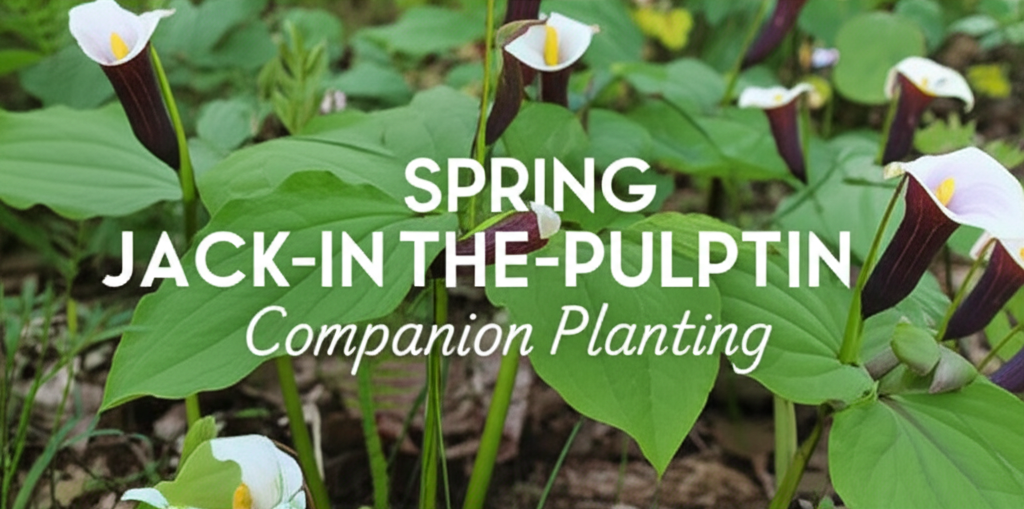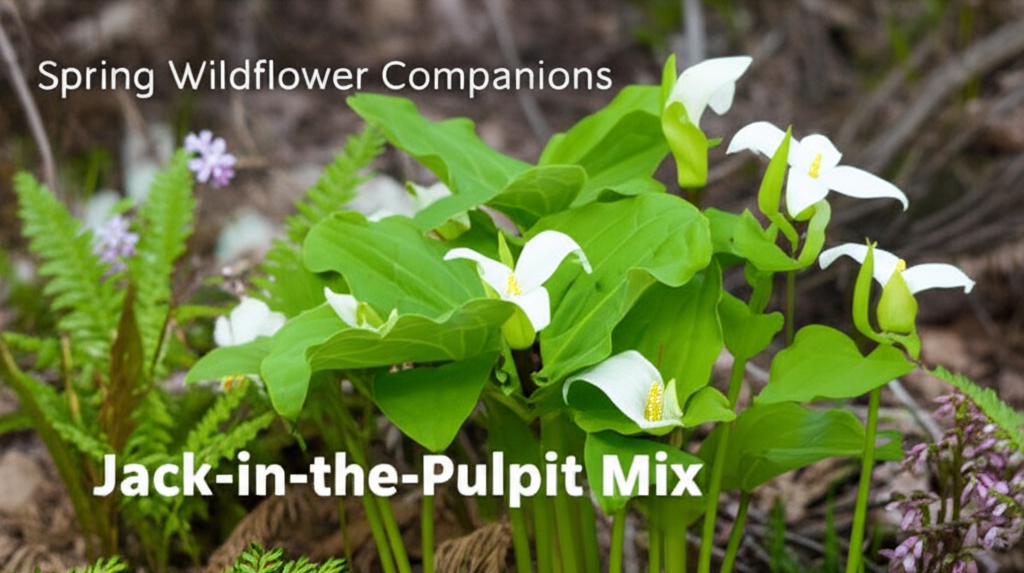Understanding Jack-in-the-Pulpit (Arisaema triphyllum)
Jack-in-the-Pulpit, scientifically known as Arisaema triphyllum, is a captivating and iconic wildflower native to the eastern and central parts of North America. Its distinctive hooded spathe, often referred to as the “pulpit,” encloses a central spadix, the “jack.” This unique bloom emerges from a corm and typically graces moist, shady woodland floors from spring through early summer. Its foliage, usually consisting of two or three trifoliate leaflets, adds lushness to the understory. Understanding its native habitat and growth requirements is crucial for successful companion planting.
Native Habitat and Growing Conditions
Jack-in-the-Pulpit thrives in dappled shade or partial shade, mimicking its natural environment beneath deciduous trees. It prefers rich, moist, well-drained soil with a high organic matter content, often found in forests with a thick layer of leaf litter. The ideal pH range is slightly acidic to neutral. Adequate moisture is essential, especially during its active growth period in spring, but the soil should not remain waterlogged. Its underground corm allows it to go dormant in the summer heat and drought, reappearing in the fall for a brief period before winter.
Key Facts About Jack-in-the-Pulpit
Here’s a quick overview of essential information for gardeners considering Jack-in-the-Pulpit:
| Characteristic | Details |
|---|---|
| Scientific Name | Arisaema triphyllum |
| Common Names | Jack-in-the-Pulpit, Indian Turnip, Wake-Robin |
| Native Range | Eastern and Central North America |
| Light Requirements | Dappled shade to partial shade |
| Soil Preference | Rich, moist, well-drained, acidic to neutral pH |
| Bloom Time | Spring to early summer |
| Height | 1 to 3 feet |
| Dormancy | Summer/Fall (after fruiting) |
| Toxicity | All parts contain calcium oxalate crystals; toxic if ingested raw. Fruit is less toxic when ripe and cooked. |
The Art of Companion Planting with Spring Wildflowers

Companion planting is an age-old horticultural practice that leverages the beneficial relationships between different plants to enhance growth, deter pests, attract pollinators, and create a more aesthetically pleasing and ecologically balanced garden. When it comes to woodland gardens, especially those featuring spring ephemerals like Jack-in-the-Pulpit, choosing the right companions is key to establishing a thriving ecosystem. The goal is to select plants that share similar environmental needs while offering mutual benefits.
Benefits of Companion Planting for Jack-in-the-Pulpit
- Moisture Retention: Groundcover plants can help retain soil moisture, which is vital for Jack-in-the-Pulpit.
- Nutrient Cycling: Certain plants can contribute to soil fertility and nutrient availability.
- Pest Deterrence: Some companion plants may naturally deter common pests that could affect Jack-in-the-Pulpit.
- Pollinator Attraction: Flowering companions can draw pollinators to the area, indirectly benefiting Jack-in-the-Pulpit if it receives any cross-pollination.
- Weed Suppression: A dense groundcover can outcompete weeds, reducing competition for resources.
- Aesthetic Appeal: A diverse planting creates visual interest throughout the spring season.
Ideal Companion Plants for Jack-in-the-Pulpit
When selecting companion plants for Jack-in-the-Pulpit, prioritize those that thrive in similar conditions: partial shade, moist, rich soil, and a slightly acidic to neutral pH. These plants should also have complementary bloom times and growth habits.
Groundcovers and Low-Growing Plants
These plants provide a living mulch, helping to keep the soil cool and moist, and suppressing weeds.
- Wild Ginger (Asarum canadense): This native groundcover features attractive kidney-shaped leaves and a low-growing habit. It thrives in shade and moist soil, making it an excellent companion. Its unique, subtle flowers are typically hidden beneath the foliage.
- Foamflower (Tiarella cordifolia): Known for its delicate, foamy white flower spikes in spring, Foamflower prefers shade and moist, organic-rich soil. Its attractive foliage persists through much of the year.
- Woodland Bluebells (Mertensia virginica): These beautiful wildflowers produce clusters of bell-shaped blue flowers in early spring. They prefer moist, shady conditions and often go dormant by summer, making them an ideal ephemeral companion.
- Virginia Creeper (Parthenocissus quinquefolia): While more vigorous, Virginia Creeper can be managed as a groundcover in larger woodland settings. Its adaptability to shade and moisture, along with its vibrant fall color, makes it a good option if controlled.
- Canada Anemone (Anemone canadensis): This adaptable native spreads readily and produces charming white flowers in late spring and early summer. It tolerates shade and moist soils, helping to fill in gaps.
Mid-Height Perennials
These plants add height and color, complementing the unique structure of Jack-in-the-Pulpit.
- Ostrich Fern (Matteuccia struthiopteris): With its striking upright fronds, the Ostrich Fern creates a dramatic vertical element. It loves moist, shady locations and adds a lush, tropical feel to the woodland garden.
- Lady Fern (Athyrium filix-femina): Another beautiful native fern, Lady Fern offers delicate, lace-like fronds. It thrives in moist, shaded conditions, pairing well with Jack-in-the-Pulpit’s texture.
- Bleeding Heart (Dicentra spectabilis or Dicentra eximia): The classic heart-shaped flowers of Bleeding Heart add a romantic touch to the spring garden. They prefer moist, shaded spots and can bloom for an extended period.
- Columbine (Aquilegia canadensis): This native Columbine offers unique, spurred flowers in shades of red and yellow. It is adaptable to partial shade and well-drained soil, blooming around the same time as Jack-in-the-Pulpit.
- Trillium species (e.g., Trillium grandiflorum, Trillium erectum): These quintessential woodland wildflowers are perfect companions. They share similar habitat needs and their stately blooms in white or deep red/purple create a classic woodland scene.
Beneficial Plants to Consider
Some plants might not be direct visual companions but offer ecological advantages.
- Wild Geranium (Geranium maculatum): This native plant with lovely pinkish-purple flowers attracts pollinators and can tolerate a range of conditions, including partial shade and moist soil.
- Solomon’s Seal (Polygonatum biflorum): With its gracefully arching stems and dangling white bell-shaped flowers, Solomon’s Seal adds elegance. It prefers partial shade and moist, humus-rich soil.
- False Solomon’s Seal (Maianthemum racemosum): Similar in habit to Solomon’s Seal, it produces fluffy white flower clusters at the stem tips. It also thrives in shady, moist conditions.
Creating a Harmonious Woodland Garden Ecosystem
The success of companion planting lies in understanding the specific needs and interactions of the plants involved. For Jack-in-the-Pulpit, creating a microhabitat that mimics a healthy forest floor is paramount.
Soil Preparation and Mulching
- Enhance Soil: Incorporate generous amounts of compost, well-rotted leaf mold, or aged bark mulch into the soil before planting. This will improve drainage, aeration, and nutrient content, mimicking the rich humus of a forest floor.
- Mulch Regularly: A layer of organic mulch, such as shredded bark, wood chips, or leaf litter, is essential. Mulch helps retain soil moisture, suppress weeds, regulate soil temperature, and provides ongoing nutrients as it decomposes.
Watering and Shade Management
- Consistent Moisture: Water regularly, especially during dry spells, ensuring the soil remains consistently moist but not waterlogged. Drip irrigation or soaker hoses are ideal for delivering water directly to the root zone.
- Strategic Shade: Ensure the planting area receives dappled sunlight or partial shade throughout the day. Avoid full sun exposure, which can scorch the delicate foliage and dry out the soil too quickly. If natural shade is insufficient, consider planting taller species or using temporary shade structures during the hottest parts of summer.
Spacing and Planting Techniques
- Appropriate Spacing: Give Jack-in-the-Pulpit and its companions adequate space to grow and spread. Overcrowding can lead to competition for resources and increased susceptibility to diseases.
- Planting Depth: Plant Jack-in-the-Pulpit corms about 3-4 inches deep, with the pointed end facing upwards. Plant companion plants according to their specific depth requirements.
- Layering: Consider planting in layers, with groundcovers at the front, mid-height perennials in the middle, and taller ferns or shrubs at the back, creating visual depth and maximizing light penetration.
Key Considerations and Potential Pitfalls
While companion planting offers numerous benefits, it’s important to be aware of potential challenges and how to mitigate them.
Table: Pros and Cons of Specific Companions
| Companion Plant | Pros | Cons |
|---|---|---|
| Wild Ginger (Asarum canadense) | Excellent groundcover, retains moisture, attractive foliage, low maintenance. | Can spread aggressively in ideal conditions, potentially outcompeting slower-growing plants if not managed. |
| Foamflower (Tiarella cordifolia) | Beautiful spring blooms, attractive foliage, good groundcover. | Can be sensitive to drought if mulch is insufficient. |
| Woodland Bluebells (Mertensia virginica) | Stunning ephemeral blooms, goes dormant, doesn’t compete after spring. | Dormancy means the patch can appear bare in summer. |
| Ostrich Fern (Matteuccia struthiopteris) | Dramatic vertical element, lush appearance, loves moist shade. | Requires consistently moist soil; can die back in dry conditions. Needs adequate space to unfurl its fronds. |
| Columbine (Aquilegia canadensis) | Attracts pollinators, unique flowers, adaptable. | Can self-seed prolifically, potentially becoming a weed in some areas. |
| Virginia Creeper (Parthenocissus quinquefolia) | Vigorous groundcover, tolerates shade and moisture, good fall color. | Can become overly aggressive and climb other plants if not managed. Its berries can be toxic if ingested. |
Avoiding Over-Competition
- Monitor Growth: Keep an eye on spreading plants and thin them out if they begin to crowd Jack-in-the-Pulpit or other desired species.
- Choose Milder Spreaders: Opt for less aggressive cultivars or varieties of groundcovers if your garden space is limited.
- Fertilize Appropriately: Over-fertilizing can stimulate aggressive growth in some plants, leading to competition. Focus on building healthy soil with organic matter rather than relying on synthetic fertilizers.
Pest and Disease Management
While companion planting can naturally deter some pests, it’s not a foolproof solution.
- Slugs and Snails: These are common pests in moist woodland gardens and can damage the foliage of Jack-in-the-Pulpit and its companions. Employing slug traps, barriers, or introducing beneficial predators like ground beetles can help.
- Fungal Diseases: Poor air circulation due to overcrowding or consistently wet foliage can lead to fungal issues. Ensure adequate spacing and avoid overhead watering late in the day.
Seasonal Interest and Long-Term Garden Health
A well-planned companion planting scheme for Jack-in-the-Pulpit extends beyond the spring bloom. The interplay of different foliage textures, growth habits, and seasonal changes creates a dynamic and resilient woodland garden.
Spring Spectacle
The primary goal for many is the stunning visual display in spring. The emergent Jack-in-the-Pulpit, often accompanied by the delicate blooms of Woodland Bluebells, Foamflower, and Columbine, creates a classic woodland tableau. The emerging fiddleheads of Ostrich Fern and the unfurling leaves of various woodland plants contribute to a tapestry of greens.
Summer and Fall Transitions
As spring flowers fade, the foliage of Jack-in-the-Pulpit begins to wither and the plant enters dormancy. However, its companions continue to provide interest. Ferns offer lush greenery, Wild Ginger’s attractive leaves persist, and plants like Wild Geranium may offer reblooming. The bright red berries of Jack-in-the-Pulpit, if pollination occurs, can provide late-season color before the plant’s foliage fully disappears. The fall foliage of plants like Virginia Creeper adds another layer of visual appeal.
Winter Structure
While most of the planting will be dormant, the skeletal structures of certain plants and the evergreen elements, if any are included in the broader woodland design, can provide subtle winter interest. The rich leaf litter, a natural byproduct of a healthy woodland ecosystem, also contributes to the overall composition.
Conclusion: Cultivating a Thriving Woodland Haven
Companion planting with spring wildflowers around Jack-in-the-Pulpit is a rewarding endeavor that fosters a healthy, beautiful, and ecologically sound woodland garden. By carefully selecting plants that share similar preferences for dappled shade, moist, rich soil, and by understanding their growth habits, you can create a symbiotic relationship that benefits all. From the ephemeral magic of spring blooms to the enduring greenery of ferns and the crucial role of groundcovers in retaining moisture, each element contributes to a vibrant, self-sustaining ecosystem. Embrace the art of companion planting to transform your shady corners into a captivating woodland haven that celebrates the unique beauty of native flora.
